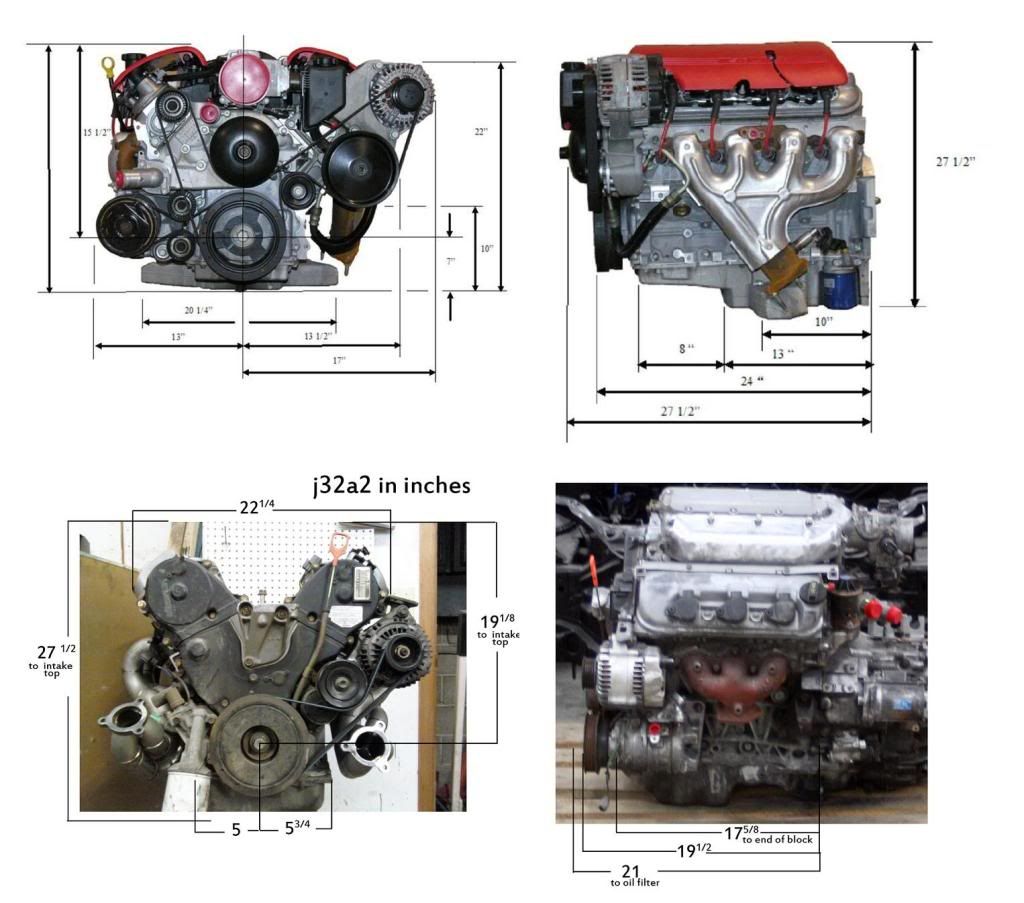Specs, Tech info, Dimensional drawings, anything and everything about the Honda J-series V6 engine. Slap it in here.
J Series Engine Specs J25
The J25A was the first J-series engine produced. It was only used in the export-model Inspire/Saber models, however. The J25A displaced 2.5 L (~153 cu in) and was an SOHC Gasoline direct injection VTEC design. Output was 192 hp (143 kW).
J25A 1998-2003 Honda Inspire 1999 Honda Saber
J30
The J30 displaces 3.0 L (~183 cu in) and is a SOHC VTEC design. Output for the light weight 250 lb (110 kg) J30A1 was 200 hp (150 kW) and 195 lb·ft (264 N·m) of torque. The J30A4 pushed output to 240 hp (180 kW) and 212 lb·ft (287 N·m) using a three-way VTEC system, higher (10:1) compression ratio, and a novel exhaust manifold cast as one piece with the cylinder head. It weighs nearly 20 lb (9.1 kg) lighter and is an inch shorter than J30A1. This version was on the Ward's 10 Best Engines list for 2003 and 2004. The IMA hybrid version was on the list for 2005. In 2006 to mark the 30th anniversary of the Accord, Honda created the J30A5, which boosted output to 244 hp (SAE Net 08/04) and 211 ft·lbf (SAE Net 08/04) of torque. According to Honda, horsepower gains were achieved with extensive improvements to the airflow of the intake and exhaust system.
J30A1 1997-1999 Acura 3.0CL 1999-2003 Honda Avancier 1998-2002 Honda Accord V6 J30A4 2003-2005 Honda Accord V6 J30A5 2006-2007 Honda Accord V6 Variable Cylinder Management 2005 Honda Accord Hybrid 2003-2007 Honda Inspire
J32
The J32 displaces 3.2 L (~195 cu in) and is a SOHC VTEC design. Bore is 89 mm (3.5 in) and stroke is 86 mm (3.4 in). Output was 225 hp (168 kW) for the J32A1, with the J32A2 raising output to 260 hp (194 kW) @ 6200 rpm and 232 lb·ft (315 N·m) @ 3500-5500 rpm. A more aggressive camshaft, freer flowing intake/exhaust, and a 2-stage intake manifold all result in a 35 hp (26 kW) increase over the J32A1. The J32A3's output in the 2004/2005 TL is 270 hp (201 kW). SAE corrected hp for the 2006-2008 TL is 258 hp (192 kW). The J32A3 also includes the one-piece exhaust manifold cast with the cylinder head, first introduced on the J30A4.
J32A1 1999-2003 Acura TL 2001-2003 Acura CL 1998-2003 Honda Inspire J32A2 2001-2003 Acura CL Type-S 2002-2003 Acura TL Type-S J32A3 2004-2008 Acura TL
J35
J35Z2The J35 displaced 3.5 L (3471 cc, 212 cu in) and is an SOHC VTEC design. Bore is 89 mm (3.5 in) and stroke is 93 mm (3.7 in). Output was 210 hp (157 kW) for the J35A1; 240 hp (179 kW) and 253 ft·lbf (343 N·m) (5800/4400 rpm) for the J35A3; 240 hp (179 kW) and 242 ft·lbf (328 N·m) (5500/4500 rpm) for the J35A4.
The J35A5 used in the 2004 - 2006 Acura MDX produces 265 hp (198 kW) at 5800 rpm and 250 ft·lbf (339 N·m) at 3500 rpm. The 2003 version of this engine produces 260 hp (194 kW) at 5750 rpm.
The new J35 used in the Acura RL produces 290 hp (220 kW) at 6200 rpm and 256 lb·ft (347 N·m) at 5000 rpm. This engine was on the Ward's 10 Best Engines list for 2005 and 2008.
The J35A9 used in the 2006 - 2008 Honda Ridgeline produces 247 hp (184 kW) at 5750 rpm and 245 lb·ft (332 N·m) at 4500 rpm.
The J35A3 was also used by General Motors in the 2004-2007 Saturn Vue, though it utilized the cast-iron crankshaft from the J35A4 rather than the forged-steel version of the J35A3. GM refers to it as the L66.
J35A1 1999 - 2001 Honda Odyssey J35A3 2001 - 2002 Acura MDX 2005 - 2008 Acura RL 2004 - 2007 Saturn Vue L66 J35A4 2002 - 2004 Honda Odyssey 2003 - 2004 Honda Pilot J35A6 2005 - 2009 Honda Odyssey Van, LX, EX 2005 Honda Pilot J35A7 - Variable Cylinder Management 2005-2009 Honda Odyssey EX-L, Touring 2007-present Honda Inspire J35A8 2007 - 2008 Acura TL Type-S J35A9 2006 - 2008 Honda Ridgeline 2006 - 2008 Honda Pilot (VTM-4-equipped models) J35Z1 - Variable Cylinder Management 2006 - 2008 Honda Pilot (front-wheel drive models)
J35Z2 - Variable Cylinder Management 2008+ Honda Accord (except V6 6MT coupe) Displacement: 3,471 cc (211.8 cu in) Bore and stroke: 89.0 mm (3.5 in) x 93.0 mm (3.7 in) Compression: 10.5:1 Power, torque: 271 hp (202 kW) @ 6200 rpm; 254 ft·lbf (344 N·m) @ 5000 rpm Valvetrain: 24v SOHC i-VTEC Fuel control: Multi-point fuel injection; PGM-FI
J35Z3 2008+ Honda Accord V6 6MT coupe Displacement: 3,471 cc (211.8 cu in) Bore and stroke: 89.0 mm (3.5 in) x 93.0 mm (3.7 in) Compression: 10.0:1 Power, torque: 271 hp (202 kW) @ 6200 rpm; 251 ft·lbf (340 N·m) @ 5000 rpm Valvetrain: 24v SOHC VTEC Fuel control: Multi-point fuel injection; PGM-FI
J35Z4 - Variable Cylinder Management 2009 Honda Pilot Displacement: 3,471 cc (211.8 cu in) Bore and stroke: 89.0 mm (3.5 in) x 93.0 mm (3.7 in) Compression: 10.5:1 Power, torque: 250 hp (190 kW) @ 5700 rpm; 253 ft·lbf (343 N·m) @ 4800 rpm Valvetrain: 24 SOHC i-VTEC Fuel control: Multi-point fuel injection; PGM-FI
J35Z5 2009 Honda Ridgeline Displacement: 3,471 cc (211.8 cu in) Bore and stroke: 89.0 mm (3.5 in) x 93.0 mm (3.7 in) Compression: 10.0:1 Power, torque: 250 hp (190 kW) @ 5700 rpm; 247 ft·lbf (335 N·m) @ 4300 rpm Valvetrain: 24v SOHC VTEC Fuel control: Multi-point fuel inection; PGM-FI
J37
J37A1 2007+ Acura MDX Displacement: 3,664 cc (223.6 cu in) Bore and stroke: 90 mm (3.5 in) x 96.0 mm (3.8 in) Compression: 11.0:1 Power; torque: 300 hp (220 kW) @ 6000 rpm; 275 ft·lbf (373 N·m) @ 5000 rpm Valvetrain: 24v SOHC VTEC Fuel control: Multi-point fuel injection; PGM-FI
J37A2 2009 Acura RL Displacement: 3,664 cc (223.6 cu in) Bore and stroke: 90 mm (3.5 in) x 96.0 mm (3.8 in) Compression: 11.2:1 Power; torque: 300 hp (220 kW) @ 6300 rpm; 271 ft·lbf (367 N·m) @ 5000 rpm Valvetrain: 24v SOHC VTEC (intake and exhaust) Fuel control: Multi-point fuel injection; PGM-FI
J37A4 2009 Acura TL SH-AWD Displacement: 3,664 cc (223.6 cu in) Bore and stroke: 90 mm (3.5 in) x 96.0 mm (3.8 in) Compression: 11.2:1 Power; torque: 305 hp (227 kW) @ 6300 rpm; 273 ft·lbf (370 N·m) @ 5000 rpm Valvetrain: 24v SOHC VTEC (intake and exhaust) Fuel control: Multi-point fuel injection; PGM-FI






























